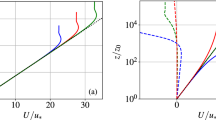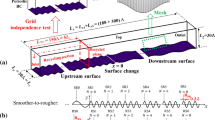Abstract
A suite of large-eddy simulations of the neutral atmospheric boundary layer is conducted to study the mean flow response to the presence of surface roughness heterogeneity at regional scales (surface roughness heterogeneity on the scale of several boundary-layer heights). The roughness heterogeneity is imposed using alternating rough wall patches with numerically resolved rectangular roughness elements of different packing densities. The flow near the surface is found to adjust rapidly, reaching equilibrium conditions at distances on the order of a single inter-roughness element spacing. Despite the regional heterogeneity in surface roughness, it is often desirable to parametrize the entire rough wall using one single effective roughness height. To develop such a parametrization the model of Bou-Zeid et al. [Water Resources Research 40(2):1, 2004] is extended to incorporate the displacement height, d. Predictions from this parametrization are compared with the simulations, with reasonably good agreement.












Similar content being viewed by others
References
Albertson JD, Parlange MB (1999a) Natural integration of scalar fluxes from complex terrain. Adv Water Resour 23(3):239–252
Albertson JD, Parlange MB (1999b) Surface length scales and shear stress: implications for land-atmosphere interaction over complex terrain. Technical report
Anderson W, Meneveau C (2011) Dynamic roughness model for large-eddy simulation of turbulent flow over multiscale, fractal-like rough surfaces. J Fluid Mech 679:288–314
Anderson W, Passalacqua P, Porté-Agel F, Meneveau C (2012) Large-eddy simulation of atmospheric boundary-layer flow over fluvial-like landscapes using a dynamic roughness model. Boundary-Layer Meteorol 144(2):263–286
Anderson W, Barros JM, Christensen KT, Awasthi A (2015a) Numerical and experimental study of mechanisms responsible for turbulent secondary flows in boundary layer flows over spanwise heterogeneous roughness. J Fluid Mech 768:316–347
Anderson W, Li Q, Bou-Zeid E (2015b) Numerical simulation of flow over urban-like topographies and evaluation of turbulence temporal attributes. J Turbul 16(9):809–831
Andreas EL, Treviño G (2000) Comments on“a physical interpretation of von kármán’s constant based on asymptotic considerations–a new value”. J Atmos Sci 57:1189–1192
Avissar R (1991) A statistical-dynamical approach to parameterize subgrid-scale land-surface heterogeneity in climate models. Land surface atmosphere interactions for climate modeling. Springer, Netherlands, pp 155–178
Avissar R, Pielke RA (1989) A parameterization of heterogeneous land surfaces for atmospheric numerical models and its impact on regional meteorology. Mon Weather Rev 117(10):2113–2136
Avissar R, Eloranta EW, Gürer K, Tripoli GJ (1998) An evaluation of the large-eddy simulation option of the regional atmospheric modeling system in simulating a convective boundary layer: a fife case study. J Atmos Sci 55(7):1109–1130
Bai K, Meneveau C, Katz J (2012) Near-wake turbulent flow structure and mixing length downstream of a fractal tree. Boundary-Layer Meteorol 143(2):285–308
Bai K, Meneveau C, Katz J (2013) Experimental study of spectral energy fluxes in turbulence generated by a fractal, tree-like object. Phys Fluids 25(11):110,810
Barros JM, Christensen KT (2014) Observations of turbulent secondary flows in a rough-wall boundary layer. J Fluid Mech 748:R1
Belcher S, Jerram N, Hunt J (2003) Adjustment of a turbulent boundary layer to a canopy of roughness elements. J Fluid Mech 488:369–398
Belcher S, Finnigan J, Harman I (2008) Flows through forest canopies in complex terrain. Ecol Appl 18(6):1436–1453
Bhardwaj R, Mittal R (2012) Benchmarking a coupled immersed-boundary-finite-element solver for large-scale flow-induced deformation. AIAA J 50(7):1638–1642
Bou-Zeid E, Meneveau C, Parlange MB (2004) Large-eddy simulation of neutral atmospheric boundary layer flow over heterogeneous surfaces: blending height and effective surface roughness. Water Resour Res 40(2):1
Bou-Zeid E, Parlange MB, Meneveau C (2007) On the parameterization of surface roughness at regional scales. J Atmos Sci 64(1):216–227
Bou-Zeid E, Overney J, Rogers BD, Parlange MB (2009) The effects of building representation and clustering in large-eddy simulations of flows in urban canopies. Boundary-Layer Meteorol 132(3):415–436
Brutsaert W, Parlange M (1992) The unstable surface layer above forest: regional evaporation and heat flux. Water Resour Res 28(EFLUM–ARTICLE–1992–001):3129–3134
Brutsaert W, Parlange M, Gash J (1989) Neutral humidity profiles in the boundary layer and regional evaporation from sparse pine forest. Ann Geophys 7:623–630
Chamorro LP, Porté-Agel F (2009) Velocity and surface shear stress distributions behind a rough-to-smooth surface transition: a simple new model. Boundary-Layer Meteorol 130(1):29–41
Cheng H, Castro IP (2002) Near-wall flow development after a step change in surface roughness. Boundary-Layer Meteorol 105(3):411–432
Cheng H, Hayden P, Robins A, Castro I (2007) Flow over cube arrays of different packing densities. J Wind Eng Ind Aerodyn 95(8):715–740
Cheng WC, Porté-Agel F (2015) Adjustment of turbulent boundary-layer flow to idealized urban surfaces: a large-eddy simulation study. Boundary-Layer Meteorol 155(2):249–270
Cionco RM (1965) A mathematical model for air flow in a vegetative canopy. J Appl Meteorol 4(4):517–522
Claussen M (1990) Area-averaging of surface fluxes in a neutrally stratified, horizontally inhomogeneous atmospheric boundary layer. Atmos Environ Part A 24(6):1349–1360
Frenzen P, Vogel CA (1995) On the magnitude and apparent range of variation of the von karman constant in the atmospheric surface layer. Boundary-Layer Meteorol 72(4):371–392
Garratt J (1990) The internal boundary layera review. Boundary-Layer Meteorol 50(1–4):171–203
Goode K, Belcher S (1999) On the parameterisation of the effective roughness length for momentum transfer over heterogeneous terrain. Boundary-Layer Meteorol 93(1):133–154
Hagishima A, Tanimoto J, Nagayama K, Meno S (2009) Aerodynamic parameters of regular arrays of rectangular blocks with various geometries. Boundary-Layer Meteorol 132(2):315–337
Harun Z, Monty JP, Mathis R, Marusic I (2013) Pressure gradient effects on the large-scale structure of turbulent boundary layers. J Fluid Mech 715:477–498
Hechtel LM, Stull RB, Moeng CH (1990) The effects of nonhomogeneous surface fluxes on the convective boundary layer: a case study using large-eddy simulation. J Atmos Sci 47(14):1721–1741
Hobbs DJ, Macdonald R, Walker S (1996) Measurements of dispersion within simulated urban arrays: a small scale wind tunnel study. Building Research Establishment
Hong J, Katz J, Schultz MP (2011) Near-wall turbulence statistics and flow structures over three-dimensional roughness in a turbulent channel flow. J Fluid Mech 667:1–37
Jackson P (1981) On the displacement height in the logarithmic velocity profile. J Fluid Mech 111:15–25
Jiang D, Jiang W, Liu H, Sun J (2008) Systematic influence of different building spacing, height and layout on mean wind and turbulent characteristics within and over urban building arrays. Wind Struct 11(4):275–289
Jiménez J (2004) Turbulent flows over rough walls. Ann Rev Fluid Mech 36(1):173–196
Khanna S, Brasseur JG (1997) Analysis of monin-obukhov similarity from large-eddy simulation. J Fluid Mech 345:251–286
Leonardi S, Castro IP (2010) Channel flow over large cube roughness: a direct numerical simulation study. J Fluid Mech 651:519–539
Macdonald R (2000) Modelling the mean velocity profile in the urban canopy layer. Boundary-Layer Meteorol 97(1):25–45
Mason P (1988) The formation of areally-averaged roughness lengths. Q J R Meteorol Soc 114(480):399–420
Mason PJ (1989) Large-eddy simulation of the convective atmospheric boundary layer. J Atmos Sci 46(11):1492–1516
Meinders E, Hanjalić K (1999) Vortex structure and heat transfer in turbulent flow over a wall-mounted matrix of cubes. Int J Heat Fluid Flow 20(3):255–267
Meneveau C (2012) The top-down model of wind farm boundary layers and its applications. J Turbul 13:N7
Mittal R, Dong H, Bozkurttas M, Najjar F, Vargas A, von Loebbecke A (2008) A versatile sharp interface immersed boundary method for incompressible flows with complex boundaries. J Comput Phys 227(10):4825–4852
Moeng CH (1984) A large-eddy-simulation model for the study of planetary boundary-layer turbulence. J Atmos Sci 41(13):2052–2062
Monin A, Obukhov A (1954) Basic laws of turbulent mixing in the surface layer of the atmosphere. Contrib Geophys Inst Acad Sci USSR 151:163–187
Nagib HM, Chauhan KA (2008) Variations of von kármán coefficient in canonical flows. Phys Fluids 20(10):1518
Oncley SP, Friehe CA, Larue JC, Businger JA, Itsweire EC, Chang SS (1996) Surface-layer fluxes, profiles, and turbulence measurements over uniform terrain under near-neutral conditions. J Atmos Sci 53(7):1029–1044
Parlange MB, Brutsaert W (1989) Regional roughness of the landes forest and surface shear stress under neutral conditions. Boundary-Layer Meteorol 48(1–2):69–81
Parlange MB, Brutsaert W (1993) Regional shear stress of broken forest from radiosonde wind profiles in the unstable surface layer. Boundary-Layer Meteorol 64(4):355–368
Perrier A, Tuzet A (1991) Land surface processes: description, theoretical approaches, and physical laws underlying their measurements. In: Schmugge TJ, André J-C (eds) Land surface evaporation. Springer, New York, pp 145–155
Placidi M, Ganapathisubramani B (2015) Effects of frontal and plan solidities on aerodynamic parameters and the roughness sublayer in turbulent boundary layers. J Fluid Mech 782:541–566
Schultz M, Schatzmann M, Leitl B (2005) Effect of roughness inhomogeneities on the development of the urban boundary layer. Int J Environ Pollut 25(1–4):105–117
Shen S, Leclerc MY (1995) How large must surface inhomogeneities be before they influence the convective boundary layer structure? a case study. Q J R Meteorol Soc 121(526):1209–1228
Vedula V, Fortini S, Seo J, Querzoli G, Mittal R (2014) Computational modeling and validation of intraventricular flow in a simple model of the left ventricle. Theor Comp Fluid Dyn 28(6):589–604
Wieringa J (1976) An objective exposure correction method for average wind speeds measured at a sheltered location. Q J R Meteorol Soc 102(431):241–253
Willingham D, Anderson W, Christensen KT, Barros JM (2014) Turbulent boundary layer flow over transverse aerodynamic roughness transitions: induced mixing and flow characterization. Phys Fluids 26(2):025,111
Yang XIA, Meneveau C (2016) Recycling inflow method for simulations of spatially evolving turbulent boundary layers over rough surfaces. J Turbul 17(1):75–93
Yang XIA, Sadique J, Mittal R, Meneveau C (2015) Integral wall model for large eddy simulations of wall-bounded turbulent flows. Phys Fluids 27(2):025,112
Yang XIA, Sadique J, Mittal R, Meneveau C (2016) Exponential roughness layer and analytical model for turbulent boundary layer flow over rectangular-prism roughness elements. J Fluid Mech 789:127
Zheng L, Hedrick TL, Mittal R (2013) A multi-fidelity modelling approach for evaluation and optimization of wing stroke aerodynamics in flapping flight. J Fluid Mech 721:118–154
Zhu X, Anderson W (2015) A large-eddy simulation study on statistical attributes of urban-like geometries relevant to parameterizing bulk aerodynamic characteristics. Bull Am Phys Soc 60:262
Acknowledgments
The authors gratefully acknowledge the Office of Naval Research and the National Science Foundation for financial support and Dr C Meneveau for generous help and fruitful discussions.
Author information
Authors and Affiliations
Corresponding author
Appendix: Fitting for \(z_o\), d
Appendix: Fitting for \(z_o\), d
Both the effective roughness height \(z_o\) and the zero-plane displacement d must be fitted for the cases XXXX. The friction velocity \(u_\tau \) is directly measured from the LES model. With knowledge of \(u_\tau \), the zero-plane displacement d is swept in \(0<d<h\). For each d, a \(z_o\) can be fitted. The zero-plane displacement is the d that yields the least-squares error between \(U/u_\tau \) and (\(1/\kappa ) \ln [(z-d)/z_o]\) in the fitted region. The corresponding \(z_o\) is the effective roughness height. The fitting error is evaluated according to
where \(z=1.5h\) to \(z=2.5h\) is the vertical range within which the logarithmic law is fitted.
We fit for \(z_o\) and d for the case 1111 as an example. The drag D within \(3\delta _0<x<9\delta _0\) is directly measured, the friction velocity is \(u_\tau =\sqrt{D/\rho A}=0.079U_0\), where A is the planar area and \(\rho \) is the fluid density, \(U_0\) is the freestream velocity. d is swept from 0 to h and the square error in logarithmic fitting is computed from \(z=1.5h\) to \(z=2.5h\). The von Karman constant \(\kappa \) is taken to be 0.4. Figure 13 shows the square error of the fitting. The minimum is located at \(d=0.64\). Compared to Fig. 6, Fig. 13 is a more direct way to check the quality of the logarithmic law fitting. The corresponding \(z_o=0.052h\).
Rights and permissions
About this article
Cite this article
Yang, X.I.A. On the Mean Flow Behaviour in the Presence of Regional-Scale Surface Roughness Heterogeneity. Boundary-Layer Meteorol 161, 127–143 (2016). https://doi.org/10.1007/s10546-016-0154-9
Received:
Accepted:
Published:
Issue Date:
DOI: https://doi.org/10.1007/s10546-016-0154-9





